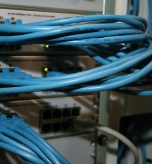Table of Contents
ToggleMaximizing Wi-Fi Performance in Large Spaces
1. The Challenge of Wi-Fi in Large Spaces
Larger homes, offices, and multi-floor buildings often struggle with Wi-Fi issues. These problems include weak signals, dropped connections, and slower speeds. Walls, floors, and other obstacles can block signals, especially over long distances. To solve these issues, your network needs a design that reaches all areas without losing speed or strength. UniFi’s networking products are built to handle these challenges. With the right setup, you can maximize coverage and performance, ensuring every corner of your space has reliable Wi-Fi.2. Using UniFi Mesh Networks for Maximum Coverage
A mesh network is one of the best ways to extend Wi-Fi in large spaces. UniFi’s mesh system uses multiple access points (APs) that work together to provide consistent coverage. Instead of relying on one router, you can place APs throughout your home or office to eliminate dead zones.- Place APs in key areas: Put them in high-traffic spaces like hallways, conference rooms, or living rooms.
- Reduce signal loss: Make sure APs are spread out evenly to avoid gaps in coverage.
- Use wired backhaul: When possible, connect APs with Ethernet cables to reduce interference and improve performance.
3. Optimizing Access Point Placement
Proper access point placement is crucial for maximizing Wi-Fi performance. Placing your UniFi access points at the right locations will significantly improve both coverage and speed. Here are some placement tips:- Mount access points high: Install them on ceilings or walls for the best signal distribution.
- Place them centrally: For best coverage, put APs in the center of each floor or room.
- Avoid obstructions: Keep APs away from thick walls, large furniture, or electronics that can block signals.
4. Fine-Tuning Your Network Settings
Even with good hardware, network settings play a huge role in performance. With UniFi, you can fine-tune your settings for better speed and reliability.- Adjust channel width: Set channel width to 20MHz or 40MHz for better stability in crowded areas.
- Use band steering: Encourage devices to connect to the 5GHz band, which is faster and less crowded than 2.4GHz.
- Enable airtime fairness: This ensures no single device hogs all the bandwidth, keeping the network balanced for everyone.
5. Leveraging UniFi’s Controller for Monitoring and Maintenance
The UniFi Controller provides a centralized dashboard to monitor and manage your network. With the controller, you can view real-time analytics, check for issues, and make changes to your network.- Monitor device traffic: See how much bandwidth each device uses and adjust settings as needed.
- Optimize channels: Use the RF Scan tool to choose the best channels for each access point, avoiding interference.
- Schedule updates: Automatically update firmware to ensure you have the latest security patches and performance improvements.




